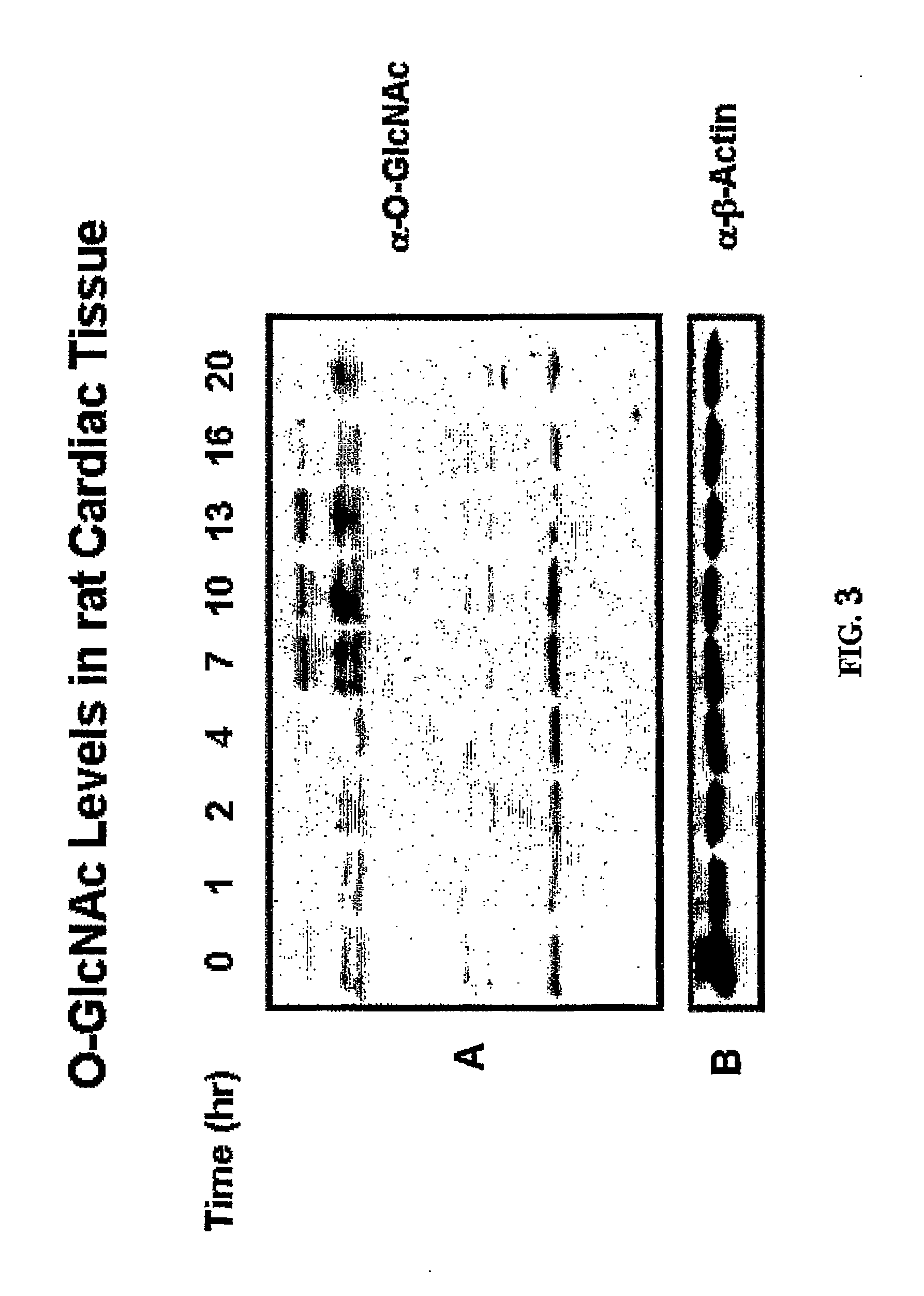Selective glycosidase inhibitors and uses thereof
a glycosidase inhibitor and selective technology, applied in the field of selective glycosidase inhibitors, can solve the problems of complex use of non-selective inhibitors in studying the physiological role of one particular enzyme in cellular and organismal biology, hyperphosphorylation of tau, and disruption of normal functions
- Summary
- Abstract
- Description
- Claims
- Application Information
AI Technical Summary
Benefits of technology
Problems solved by technology
Method used
Image
Examples
example 1
Compounds 1 and 2: (3aR,5R,6S,7R,7aR)-5-(acetoxymethyl)-2-(fluoromethyl)-5,6,7,7a-tetrahydro-3aH-pyrano[3,2-d]thiazole-6,7-diyl diacetate (1) and (3aR,5R,6S,7R,7aR)-2-(fluoromethyl)-5-(hydroxymethyl)-5,6,7,7a-tetrahydro-3aH-pyrano[3,2-d]thiazole-6,7-diol (2)
[0147]
[0148]Triethylamine (0.8 mL) and dry pyridine (20 mL) were added to a cooled (0° C.) solution of 2-amino-2-deoxy-1,3,4,6-tetra-O-acetyl-β-D-glucopyranose hydrochloride (1 g) in a solution of DMF (100 mL). Sodium fluoroacetate (1.8 g) was added to a stirred mixture of dry DMF (90 mL) containing dried Dowex 50-H+ resin (12 g). After 1 h, DCC (3.2 g) and 30 mL of the fluoroacetic acid solution were added via cannula to the reaction vessel containing the hydrochloride salt. The resulting solution was allowed to stand for 16 h at 0° C., after which time the reaction was judged complete by TLC analysis. The solvent was partially removed in vacuo and EtOAc (300 mL) and a solution of saturated sodium chloride (100 mL) were added. T...
example 2
Compounds 3 and 4: (3aR,5R,6S,7R,7aR)-5-(acetoxymethyl)-2-(difluoromethyl)-5,6,7,7a-tetrahydro-3aH-pyrano[3,2-d]thiazole-6,7-diyl diacetate (3) and (3aR,5R,6S,7R,7aR)-2-(difluoromethyl)-5-(hydroxymethyl)-5,6,7,7a-tetrahydro-3aH-pyrano[3,2-d]thiazole-6,7-diol (4)
[0150]
[0151]Triethylamine (0.8 mL) and dry pyridine (20 mL) were added to a cooled (0° C.) solution of 2-amino-2-deoxy-1,3,4,6-tetra-O-acetyl-β-D-glucopyranose hydrochloride (1 g) in a solution of DMF (100 mL). Dicyclohexylcarbodiimide (DCC, 3 g) and difluoroacetic acid (1.2 mL) were added to the reaction mixture via syringe. The resulting solution was allowed to stand for 16 h at 0° C., after which time another 0.5 mL of difluoroacetic acid were added. After a further 3.5 h at room temperature, the reaction was judged complete by TLC analysis. The solvent was partially removed in vacuo and EtOAc (300 mL) and a solution of saturated sodium chloride (100 mL) were added. The organic layer was collected, and the aqueous layer wa...
example 3
Compounds 5 and 6: (3aR,5R,6S,7R,7aR)-5-(acetoxymethyl)-2-(trifluoromethyl)-5,6,7,7a-tetrahydro-3aH-pyrano[3,2-d]thiazole-6,7-diyl diacetate (5) and (3aR,5R,6S,7R,7aR)-5-(hydroxymethyl)-2-(trifluoromethyl)-5,6,7,7a-tetrahydro-3aH-pyrano[3,2-d]thiazole-6,7-diol (6)
[0153]
[0154]Triethylamine (0.8 mL) was added to a solution of 2-amino-2-deoxy-1,3,4,6-tetra-β-acetyl-β-D-glucopyranose hydrochloride (1 g) dissolved in dry dichloromethane (20 mL) and cooled (0° C.). Trifluoroacetic anhydride (0.6 mL) was added via syringe and the resulting solution was allowed to stand for 16 h at 0° C., after which time the reaction was judged complete by TLC analysis. The solution was diluted in 50 mL of EtOAc and washed successively with water, twice with saturated aqueous NaHCO3, and finally with a solution of brine. The organic extracts were dried over MgSO4 and filtered, and the solvent was removed in vacuo to yield colorless syrup. The desired product was purified using flash chromatography on silic...
PUM
| Property | Measurement | Unit |
|---|---|---|
| pH | aaaaa | aaaaa |
| concentration | aaaaa | aaaaa |
| concentration | aaaaa | aaaaa |
Abstract
Description
Claims
Application Information
 Login to View More
Login to View More - Generate Ideas
- Intellectual Property
- Life Sciences
- Materials
- Tech Scout
- Unparalleled Data Quality
- Higher Quality Content
- 60% Fewer Hallucinations
Browse by: Latest US Patents, China's latest patents, Technical Efficacy Thesaurus, Application Domain, Technology Topic, Popular Technical Reports.
© 2025 PatSnap. All rights reserved.Legal|Privacy policy|Modern Slavery Act Transparency Statement|Sitemap|About US| Contact US: help@patsnap.com



